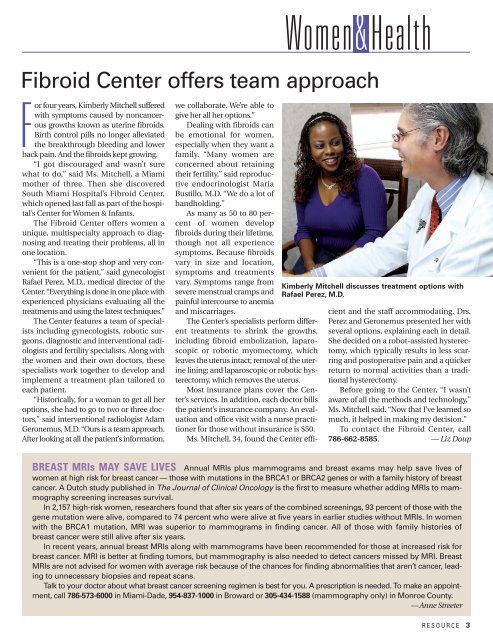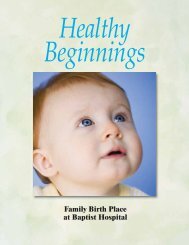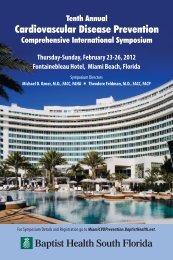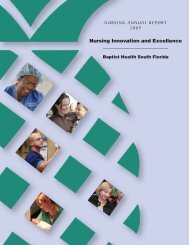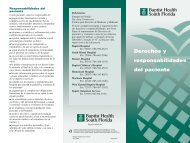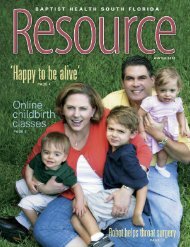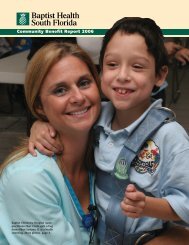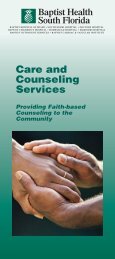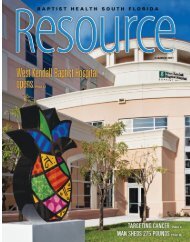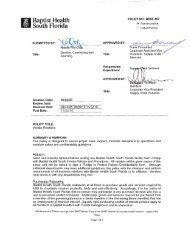SPRING 2011 - Baptist Health South Florida
SPRING 2011 - Baptist Health South Florida
SPRING 2011 - Baptist Health South Florida
You also want an ePaper? Increase the reach of your titles
YUMPU automatically turns print PDFs into web optimized ePapers that Google loves.
Women&<strong>Health</strong><br />
Fibroid Center offers team approach<br />
F<br />
or four years, Kimberly Mitchell suffered<br />
with symptoms caused by noncancerous<br />
growths known as uterine fibroids.<br />
Birth control pills no longer alleviated<br />
the breakthrough bleeding and lower<br />
back pain. And the fibroids kept growing.<br />
“I got discouraged and wasn’t sure<br />
what to do,” said Ms. Mitchell, a Miami<br />
mother of three. Then she discovered<br />
<strong>South</strong> Miami Hospital’s Fibroid Center,<br />
which opened last fall as part of the hospital’s<br />
Center for Women & Infants.<br />
The Fibroid Center offers women a<br />
unique, multispecialty approach to diagnosing<br />
and treating their problems, all in<br />
one location.<br />
“This is a one-stop shop and very convenient<br />
for the patient,” said gynecologist<br />
Rafael Perez, M.D., medical director of the<br />
Center. “Everything is done in one place with<br />
experienced physicians evaluating all the<br />
treatments and using the latest techniques.”<br />
The Center features a team of specialists<br />
including gynecologists, robotic surgeons,<br />
diagnostic and interventional radiologists<br />
and fertility specialists. Along with<br />
the women and their own doctors, these<br />
specialists work together to develop and<br />
implement a treatment plan tailored to<br />
each patient.<br />
“Historically, for a woman to get all her<br />
options, she had to go to two or three doctors,’’<br />
said interventional radiologist Adam<br />
Geronemus, M.D. “Ours is a team approach.<br />
After looking at all the patient’s information,<br />
Kimberly Mitchell discusses treatment options with<br />
Rafael Perez, M.D.<br />
we collaborate. We’re able to<br />
give her all her options.”<br />
Dealing with fibroids can<br />
be emotional for women,<br />
especially when they want a<br />
family. “Many women are<br />
concerned about retaining<br />
their fertility,” said reproductive<br />
endocrinologist Maria<br />
Bustillo, M.D. “We do a lot of<br />
handholding.’’<br />
As many as 50 to 80 percent<br />
of women develop<br />
fibroids during their lifetime,<br />
though not all experience<br />
symptoms. Because fibroids<br />
vary in size and location,<br />
symptoms and treatments<br />
vary. Symptoms range from<br />
severe menstrual cramps and<br />
painful intercourse to anemia<br />
and miscarriages.<br />
The Center’s specialists perform different<br />
treatments to shrink the growths,<br />
including fibroid embolization, laparoscopic<br />
or robotic myomectomy, which<br />
leaves the uterus intact; removal of the uterine<br />
lining; and laparoscopic or robotic hysterectomy,<br />
which removes the uterus.<br />
Most insurance plans cover the Center’s<br />
services. In addition, each doctor bills<br />
the patient’s insurance company. An evaluation<br />
and office visit with a nurse practitioner<br />
for those without insurance is $50.<br />
Ms. Mitchell, 34, found the Center efficient<br />
and the staff accommodating. Drs.<br />
Perez and Geronemus presented her with<br />
several options, explaining each in detail.<br />
She decided on a robot-assisted hysterectomy,<br />
which typically results in less scarring<br />
and postoperative pain and a quicker<br />
return to normal activities than a traditional<br />
hysterectomy.<br />
Before going to the Center, “I wasn’t<br />
aware of all the methods and technology,’’<br />
Ms. Mitchell said. “Now that I’ve learned so<br />
much, it helped in making my decision.”<br />
To contact the Fibroid Center, call<br />
786-662-8585. — Liz Doup<br />
BREAST MRIs MAY SAVE LIVES<br />
Annual MRIs plus mammograms and breast exams may help save lives of<br />
women at high risk for breast cancer — those with mutations in the BRCA1 or BRCA2 genes or with a family history of breast<br />
cancer. A Dutch study published in The Journal of Clinical Oncology is the first to measure whether adding MRIs to mammography<br />
screening increases survival.<br />
In 2,157 high-risk women, researchers found that after six years of the combined screenings, 93 percent of those with the<br />
gene mutation were alive, compared to 74 percent who were alive at five years in earlier studies without MRIs. In women<br />
with the BRCA1 mutation, MRI was superior to mammograms in finding cancer. All of those with family histories of<br />
breast cancer were still alive after six years.<br />
In recent years, annual breast MRIs along with mammograms have been recommended for those at increased risk for<br />
breast cancer. MRI is better at finding tumors, but mammography is also needed to detect cancers missed by MRI. Breast<br />
MRIs are not advised for women with average risk because of the chances for finding abnormalities that aren’t cancer, leading<br />
to unnecessary biopsies and repeat scans.<br />
Talk to your doctor about what breast cancer screening regimen is best for you. A prescription is needed. To make an appointment,<br />
call 786-573-6000 in Miami-Dade, 954-837-1000 in Broward or 305-434-1588 (mammography only) in Monroe County.<br />
—Anne Streeter<br />
RESOURCE 3


